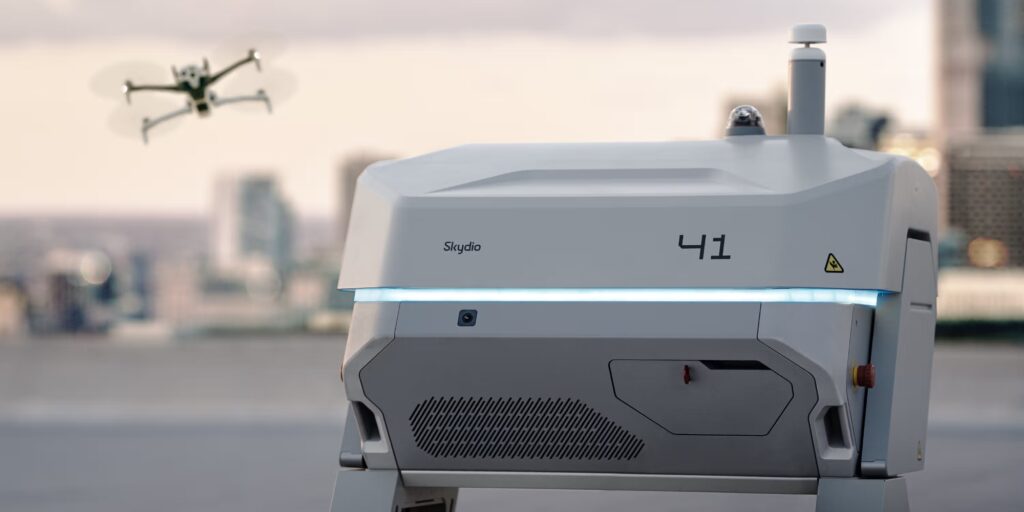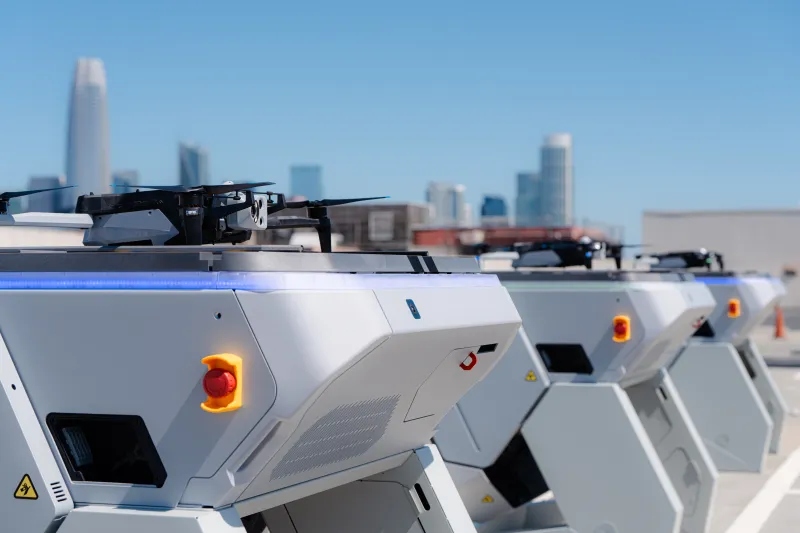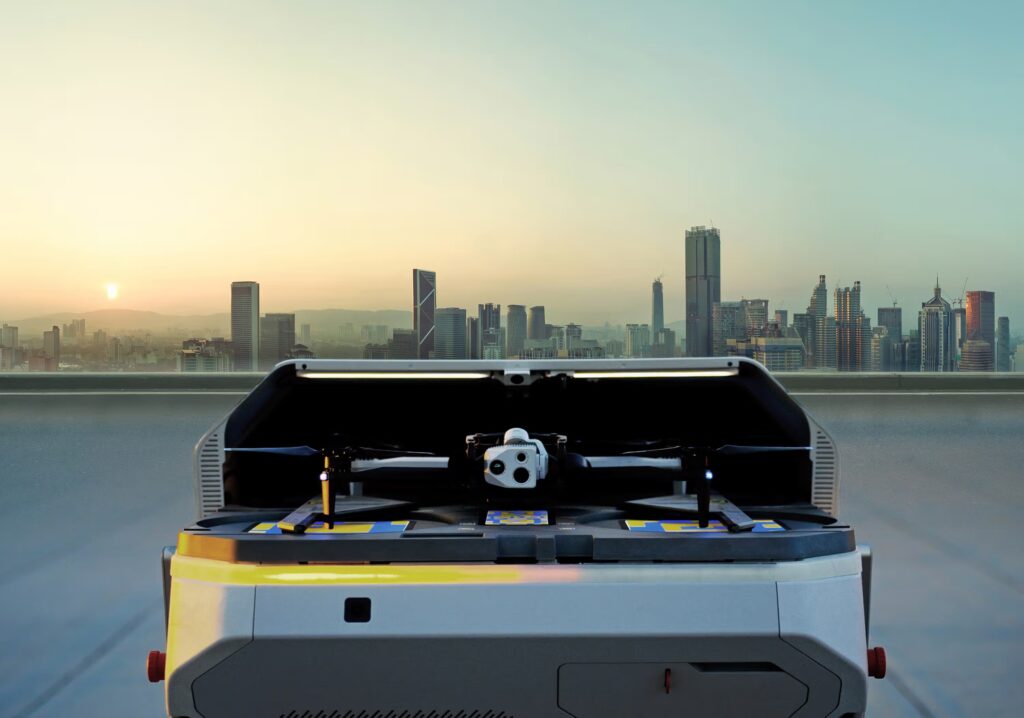
Article
Why Does MFE Need a BVLOS Waiver Anyway?
 But now it’s possible. The Skydio X10 and Dock are a solution for fully remote drone operations, enabling continuous monitoring and remote data gathering—without on-site personnel needed for flying the drone.
Skydio’s advanced autonomy is a key enabler here: the X10 can intelligently navigate complex environments, avoid obstacles, and execute inspection missions with minimal human intervention, making remote operations both safer and more reliable.
The problem?
You can’t just buy the drone and the dock and get started. First, you need to get approval from the FAA to fly Beyond Visual Line of Sight (BVLOS). That’s because all remote drone operations are BVLOS by definition, since the pilot is not physically present to keep the drone in their visual line of sight.
The good news is that Skydio has a team devoted to helping companies navigate regulatory complexity. That’s why we partnered with Skydio to secure a BVLOS waiver that allows us to ship a Skydio Dock and X10 to a client’s location and fly the drone remotely from our Houston office, providing a truly remote, real-world demonstration.
Keep reading to learn more about why we got the waiver, what we plan to do with it, and the support we got from Skydio to make this possible.
But now it’s possible. The Skydio X10 and Dock are a solution for fully remote drone operations, enabling continuous monitoring and remote data gathering—without on-site personnel needed for flying the drone.
Skydio’s advanced autonomy is a key enabler here: the X10 can intelligently navigate complex environments, avoid obstacles, and execute inspection missions with minimal human intervention, making remote operations both safer and more reliable.
The problem?
You can’t just buy the drone and the dock and get started. First, you need to get approval from the FAA to fly Beyond Visual Line of Sight (BVLOS). That’s because all remote drone operations are BVLOS by definition, since the pilot is not physically present to keep the drone in their visual line of sight.
The good news is that Skydio has a team devoted to helping companies navigate regulatory complexity. That’s why we partnered with Skydio to secure a BVLOS waiver that allows us to ship a Skydio Dock and X10 to a client’s location and fly the drone remotely from our Houston office, providing a truly remote, real-world demonstration.
Keep reading to learn more about why we got the waiver, what we plan to do with it, and the support we got from Skydio to make this possible. Why Does MFE Need a BVLOS Waiver?
Getting a BVLOS waiver is a long, expensive process.
Going through that process makes sense if you offer inspection services, or if you own a company that does inspections.
But we don’t do either of those things—what we do is provide end users and service providers with inspection solutions. So why did we need a waiver?
Because our clients need to see remote operations in action to fully grasp their potential.
With the waiver, we can ship the Dock and an X10 to a client’s location and fly it remotely, using the X10 to collect actionable data the client can actually use. Doing live remote demos like this will let us show how the technology works in the field, showcasing the power of remote drone ops.
How Companies Use Remote Drone Operations
Wondering how companies are actually leveraging remote drone operations?
In industries like Oil and Gas, drone-in-a-box solutions are increasingly being used to inspect pipelines and offshore rigs in remote locations. And in Power Generation, they’re being used to inspect transmission lines, wind turbines, and substations.
Much of this is possible thanks to the autonomous capabilities built into modern drones. Features like automated flight paths, obstacle avoidance, and intelligent data capture allow operators to trust that inspections will be carried out accurately and efficiently, even when managed from afar.
Here are some of the most common ways drones and docks like the X10 and its Dock are being used today:
- Asset inspection. Deploying remotely from a dock, the drone autonomously follows pre-planned routes to collect inspection data for assets like powerlines or pipelines.
- Remote monitoring. Using autonomous flight, drones can be deployed remotely to monitor infrastructure or environmental conditions, adjusting their path as needed without manual piloting.
- Emergency Response (ERT). In emergencies, drones can be deployed from their dock to provide aerial data for real-time decision-making.
- Mapping & surveying. Remotely operated drones can collect high-resolution imagery and data for mapping and surveying large areas.
- Visualizing assets with digital twins. Drones can gather data to create up-to-date digital twins of physical assets for condition analysis, progress monitoring, or site safety evaluations.
Remote operations allow for continuous monitoring of critical assets, improving safety and efficiency by reducing the need for manual inspections in hazardous or challenging environments.
By controlling drones from a distance we can reduce on-site risks, improve efficiency, and access areas that were once difficult or dangerous to reach.
The Skydio X10 and its Dock make all of this possible.
The X10 operates autonomously, following pre-programmed routes to collect vital inspection data. When it needs to recharge or transfer data, it returns to its Dock—no human operator required. This system allows drones to conduct inspections over long periods and across vast areas.

The Importance of Having a Regulatory Services Partner
We’re living in an incredible era for drone technology, in which drones can fly remotely, collect the inspection data you need, and return to their dock to charge up for the next deployment. And all without a person on-site. But to fully leverage this technology, you need to navigate complex regulations and get FAA approval to fly BVLOS. Getting the right approvals from the FAA for remote drone operations requires an in-depth understanding of regulations and multiple rounds of review. It’s a process that can be overwhelming for any company looking to use drones at scale. This is where Skydio comes in. In 2022, Skydio launched Skydio Regulatory Services to help companies like MFE navigate these hurdles. Since then, Skydio has helped businesses secure about 50 BVLOS waivers—or about 10% of all BVLOS approvals that have been granted—streamlining the regulatory process for advanced drone operations. At MFE, we can speak first-hand to the benefits of having an expert advisor to interface with the FAA. When we were close to receiving our final waiver, the Skydio team caught a crucial error: The FAA had accidentally issued us a waiver that would require the presence of a visual observer. This requirement would have made the waiver useless for demonstrating remote ops, since we’d still need to have someone physically present observing the drone. Because the Skydio team caught the mistake early in the process they were able to work with the FAA to correct it, saving us a lot of time and ensuring we received the correct waiver. Skydio also helped us streamline our application, consolidating all the operational conditions we wanted in a single waiver rather than facing the complexity of securing multiple certificates. With the BVLOS waiver in place, MFE is now able to demonstrate remote drone operations as part of a larger inspection and monitoring strategy, giving clients a firsthand experience of how autonomous drones like the Skydio X10 and Dock can deliver real value in operational environments.What’s Next?
This collaboration between MFE and Skydio is about more than just securing a waiver—it’s about enabling the future of remote drone operations. And we believe that future is clear: remote drone operations will become more and more integral to heavy industries like Oil and Gas, Power Generation, and Chemicals. Drones will remotely monitor, inspect, and even maintain assets, reducing the need for a constant human presence on-site. And unlocking BVLOS operations is a key part of being able to leverage drones for remote operations. As autonomy continues to improve, drones will be able to perform increasingly complex missions on their own, further expanding the possibilities for remote inspections and asset management. With our BVLOS waiver in hand, MFE is set to begin live remote drone ops demos at client locations across the country.
These demos will show how drones can remotely deploy, perform inspections, and collect data with no on-site personnel required—pilots can operate the system from a remote command center hundreds or even thousands of miles away. Doing this will let clients see the technology in action, helping them understand how it can fit into their operations.
This waiver positions MFE at the forefront of the transition to fully remote drone operations, just as the FAA prepares to release new BVLOS rules under Part 108, which are expected to streamline and accelerate adoption across the industry.
While it’s unclear when the new rules will take effect, they promise to streamline BVLOS operations and pave the way for more widespread use of remote drone operations with platforms like the X10 and its Dock.
We’re excited to lead the charge in this new era of drone inspections. With our BVLOS waiver and ongoing regulatory support, we’re ready to push forward and make remote drone operations the standard for all the industries in which we work.
With our BVLOS waiver in hand, MFE is set to begin live remote drone ops demos at client locations across the country.
These demos will show how drones can remotely deploy, perform inspections, and collect data with no on-site personnel required—pilots can operate the system from a remote command center hundreds or even thousands of miles away. Doing this will let clients see the technology in action, helping them understand how it can fit into their operations.
This waiver positions MFE at the forefront of the transition to fully remote drone operations, just as the FAA prepares to release new BVLOS rules under Part 108, which are expected to streamline and accelerate adoption across the industry.
While it’s unclear when the new rules will take effect, they promise to streamline BVLOS operations and pave the way for more widespread use of remote drone operations with platforms like the X10 and its Dock.
We’re excited to lead the charge in this new era of drone inspections. With our BVLOS waiver and ongoing regulatory support, we’re ready to push forward and make remote drone operations the standard for all the industries in which we work. 
